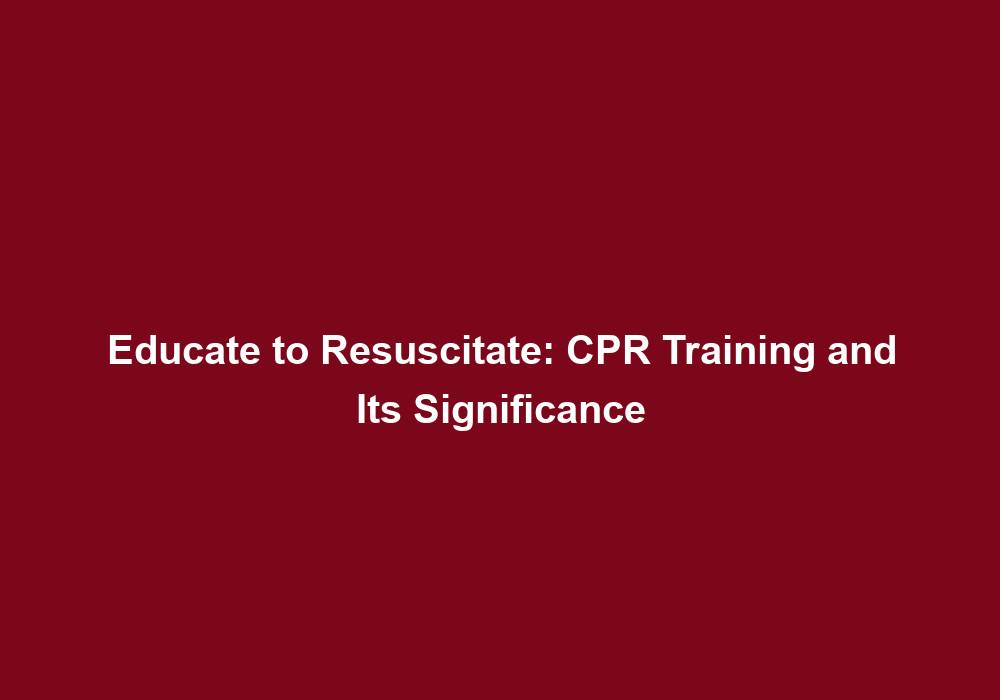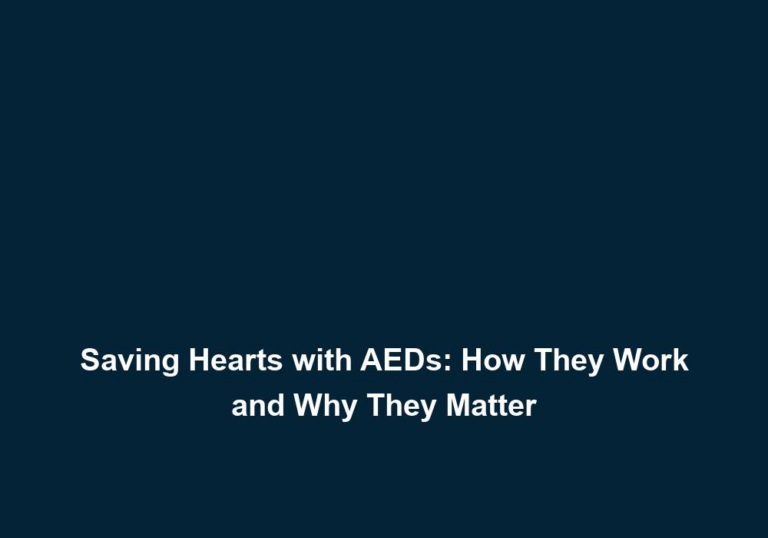Educate to Resuscitate: CPR Training and Its Significance
Cardiopulmonary resuscitation (CPR) is a life-saving technique that can significantly increase the chances of survival for individuals experiencing cardiac arrest. In emergency situations, knowing how to perform CPR can mean the difference between life and death. This article delves into the importance of CPR training, its significance in saving lives, and the benefits of being adequately prepared to respond to such emergencies.
The Vital Role of CPR in Saving Lives
-
Immediate Response: When a person’s heart stops beating, immediate intervention is crucial. CPR involves a combination of chest compressions and rescue breaths to maintain blood circulation and deliver oxygen to vital organs until professional medical help arrives.
- Chest compressions: By pressing down on the chest, CPR helps pump blood manually, ensuring that oxygen reaches the brain and other organs.
- Rescue breaths: These breaths provide oxygen to the lungs, allowing the body to continue functioning until professional medical assistance is available.
-
Buy Time: CPR helps buy time for emergency medical services to reach the scene. It sustains blood flow to vital organs, particularly the brain, which can prevent permanent damage and increase the chances of a successful resuscitation.
- Blood flow to the brain: CPR maintains blood circulation, preventing brain cells from dying due to lack of oxygen. This improves the likelihood of a positive outcome.
- Preventing organ damage: By maintaining blood flow, CPR helps prevent damage to other vital organs, such as the heart and kidneys, during the critical minutes before professional help arrives.
-
Bystander Empowerment: CPR training empowers bystanders to take action during emergencies. When every second counts, having individuals nearby who are trained in CPR can make a significant difference in the outcome.
- Increased chances of survival: Bystanders trained in CPR can initiate life-saving measures immediately, increasing the chances of survival before professional medical help arrives.
- Quick response: Trained individuals are more likely to recognize the signs of cardiac arrest and respond promptly, potentially preventing irreversible damage or death.
The Significance of CPR Training
-
Improved Survival Rates: Studies have indicated that immediate CPR can double or even triple the chances of survival for individuals experiencing cardiac arrest outside a hospital setting. The more people trained in CPR, the higher the chances of someone receiving this life-saving intervention.
- Chain of survival: CPR is a crucial link in the chain of survival, which includes early recognition, immediate CPR, defibrillation, and advanced medical care. Each step contributes to improving the overall survival rates.
- Public access defibrillation: CPR training often includes education on how to use automated external defibrillators (AEDs), which can restore normal heart rhythm in certain cases of cardiac arrest.
-
Confidence and Quick Response: CPR training equips individuals with the knowledge and skills necessary to respond promptly and effectively during emergencies. By understanding the correct techniques and being familiar with the steps involved, trained individuals can act with confidence, potentially saving lives.
- Hands-on practice: CPR training typically involves practical sessions where participants practice chest compressions, rescue breaths, and the use of AEDs. This hands-on experience builds confidence in performing CPR correctly.
- Familiarity with emergency protocols: Trained individuals learn to assess the situation, activate emergency medical services, and provide immediate care while awaiting professional help.
-
Community Resilience: CPR training promotes community resilience by creating a network of individuals who are prepared to respond to emergencies. This enhanced readiness can significantly contribute to the safety and well-being of communities.
- Community responders: Trained individuals can serve as first responders in their communities, providing immediate assistance until professional help arrives.
- Public awareness: Widespread CPR training raises awareness about the importance of early intervention and encourages community members to take responsibility for each other’s well-being.
CPR Training: What to Expect
-
Hands-on Training: CPR training usually involves hands-on practice sessions to ensure participants understand and can perform the correct techniques. These sessions may include practicing chest compressions, rescue breaths, and the use of automated external defibrillators (AEDs) if available.
- Correct technique demonstration: Trainers demonstrate the correct hand placement, compression depth, and rescue breaths, allowing participants to observe and learn.
- Feedback and correction: During hands-on practice, trainers provide individual feedback and correction to ensure participants master the proper CPR techniques.
-
Certification Courses: Many organizations offer certification courses in CPR, which provide participants with formal recognition of their training. These courses often cover not only adult CPR but also pediatric CPR and other life-saving techniques tailored to different age groups.
- Comprehensive curriculum: Certification courses cover a range of topics, including CPR techniques, recognizing cardiac arrest, using AEDs, and responding to choking emergencies.
- Validity and renewal: CPR certification is typically valid for a certain period, after which individuals are encouraged to renew their training to stay updated on the latest guidelines and techniques.
-
Refresher Courses: Regularly refreshing CPR skills is essential to ensure individuals stay up to date with any changes in guidelines or techniques. Refresher courses help maintain confidence and proficiency in performing CPR.
- Updates on guidelines: CPR guidelines may change periodically, and refresher courses provide an opportunity to learn about any updates or modifications.
- Skill reinforcement: Refresher courses allow participants to practice CPR techniques, ensuring they retain their proficiency in performing life-saving measures.
Who Should Learn CPR?
-
Everyone: CPR training is beneficial for individuals of all ages and backgrounds. Whether you are a parent, teacher, healthcare professional, or simply a concerned citizen, learning CPR can make a significant difference in an emergency situation.
- Parental preparedness: Parents who are trained in CPR can provide immediate care to their children in case of an emergency, potentially saving their lives.
- Workplace preparedness: CPR training in the workplace ensures that employees can respond effectively to medical emergencies that may occur on the premises.
-
High-Risk Professions: Certain professions, such as healthcare workers, lifeguards, and childcare providers, often require CPR training as part of their job requirements. These individuals have a greater chance of encountering emergency situations and may need to respond immediately to save lives.
- Healthcare settings: CPR is a vital skill for healthcare professionals, as they often encounter patients in critical conditions or during medical procedures.
- Aquatic environments: Lifeguards and swimming instructors are trained in CPR to respond to water-related emergencies, such as drowning incidents.
-
Schools and Educational Institutions: Incorporating CPR training into school curriculums can help create a new generation of individuals who are prepared to respond in emergencies. By teaching CPR early on, we can foster a culture of safety and empower young people to take action when it matters most.
- Student empowerment: CPR training equips students with life-saving skills, instilling a sense of responsibility and preparedness from a young age.
- Safe school environments: By training teachers and staff in CPR, schools can ensure a safer environment for students, as immediate medical assistance can be provided during emergencies.
The Benefits of CPR Training
-
Increased Confidence: CPR training instills confidence in individuals, enabling them to take immediate action during emergencies. This confidence can extend to other areas of life, creating a sense of empowerment and preparedness.
- Ability to make a difference: Knowing how to perform CPR gives individuals the confidence to step forward and potentially save a life in critical situations.
- Overcoming fear and panic: CPR training helps individuals overcome their fear and panic reactions during emergencies, allowing them to respond calmly and effectively.
-
Empathy and Compassion: CPR training not only equips individuals with life-saving skills but also fosters empathy and compassion for others. By understanding the importance of timely intervention, trained individuals may develop a deeper sense of responsibility towards the well-being of their community.
- Understanding the impact: Trained individuals become aware of the life-saving potential of CPR, leading to increased empathy and compassion for those in need of immediate assistance.
- Building stronger communities: CPR training encourages individuals to support and care for one another, fostering a sense of community and social responsibility.
-
Health and Safety Awareness: CPR training often goes hand in hand with education on recognizing the signs of cardiac arrest and other life-threatening conditions. This increased awareness can lead to early recognition of emergencies, prompt activation of emergency medical services, and improved overall safety within communities.
- Early intervention: Trained individuals can recognize the signs of cardiac arrest or other medical emergencies, allowing for early activation of emergency medical services and potentially preventing further complications.
- Promoting a culture of safety: Widespread CPR training creates a safety-conscious society, where individuals are alert to potential emergencies and take appropriate measures to prevent harm.
In conclusion, CPR training is of utmost significance in equipping individuals with the knowledge and skills needed to save lives during emergencies. By learning CPR, individuals become empowered to respond immediately, buy time for professional medical help to arrive, and significantly increase the chances of survival for those experiencing cardiac arrest. The importance of widespread CPR training cannot be overstated. Together, let’s educate to resuscitate and create a safer and more prepared society.







